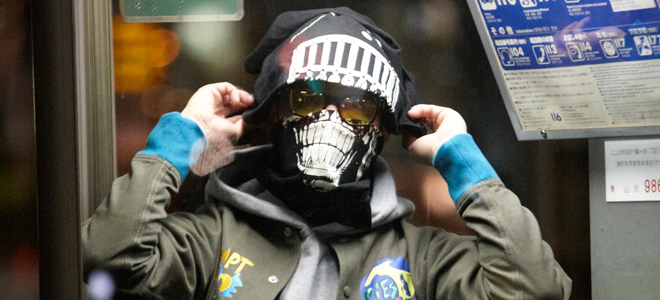Sk8ightTing
C.E
Graphic designer/illustrator/DJ from Tokyo.
Has worked on the design of street-wear apparel brands from the late 1980s through to the 1990s and to the present.. Main brands include GOOD ENOUGH, A BATHING APE® and BILLIONAIRE BOYS CLUB. In 2011, he launched the apparel brand "C.E" together with Toby.F (London) and Yutaka.H (Tokyo).
He is also active in the art/experimental band/unit "the Changes" along with Misha Perks, Mini Perks (Melbourne), and Fergadelic (London), as well as in the unit "the Nomars" with Kan Takagi (Zushi) and Keigo Oyamada (Tokyo) in the field of experimental music, etc. His written works include "Namida no kaijū pātī" (published by Asukashinsha Publishing), etc.
In VERSUS TOKYO, which was held on the last day of the Mercedes-Benz Fashion Week TOKYO 2013-14 A/W, C.E caused a sensation when the latest collection was presented using a method called projection mapping. Although the brand was launched in 2011, the designer Sk8ightTing has been working as a graphic designer from the 1980s, and is one of the founders of popular brands such as GOOD ENOUGH and A BATHING APE®, which became social phenomena. Why did he decide to launch a new brand, C.E? We asked Sk8ightTing various questions regarding his background, why he launched C.E, and about VERSUS TOKYO, etc.
*This interview was conducted by e-mail, and the responses were provided by Sk8ightTing.
What made you start graphic design?
I wanted to express the influence I got from skateboarding, hip-hop, and house music in clothing. In 1989, I launched the clothing apparel brand “GOOD ENOUGH” with Hiroshi Fujiwara and others, and in 1993, I launched “A BATHING APE®” with NIGO® and others. In 2011, I launched my new brand “C.E” with Toby.F of London and Yutaka.H of Tokyo
What is the background to the launch of C.E.?
Toby.F, one of the founding members, originally worked in A&R for the U.K. label XL Recordings and signed Dizzee Rascal, etc., and was a supporter of grime and jungle music. The brand started with an attempt to express general London club music in clothing. A big motivator for the establishment of the brand was our curiosity of whether (C.E would) function as a uniform for the scenes of electronic music and on-line rap music that echo throughout the city every night, where youth of various nationalities express themselves experimentally.
What do you think is the biggest difference between the early 1990s, when you launched GOOD ENOUGH and A BATHING APE®, etc., and early 2010, when you launched C.E; that is, the current fashion scene?
In the early 1990s, the Internet was still not very popular, so I think it was a totally different world. This is not limited to the fashion scene, but most of the world today is like a world that was printed out, and it is very interesting to me since it appears sort of like the polygon mapping that was used in games in the early 90s.
Can you give us some examples of fashion brands, designers, and artists that influenced you?
Hussein Chalayan.
Because of how he blends different genres such as fashion, modern art, improvisation, and interactive art, etc.
What is theme and image source for your 2013-14 Fall-Winter collection that was announced this March?
The theme is “post modern casual hoodies bring back golden era jungle and symbolic representation of the city.”
Our image source was live display chance operation simulation that mixes on-line differing simulacra such as the flyer art of music gigs, the London riots of 2011, the power violence of California, Astrogrind of Athens, and The House of The Yellow Carpet of Rome.

C.E 2013-14 A/W Collection
What is the reason for choosing projection mapping for your first show for C.E?
The fact that we used an interactive method is almost accidental, but the work was ultimately a cooperative effort by people of many different nationalities — the mapping and CG was done by people in Tokyo and France; the live-action shooting, music production, and art, etc., was done by people in New York, London, and Belgium; and the clothing design and production was done by people in China and Japan, etc. I think it was very significant that our work, the creation of which went beyond the scope of nationalities and political ideologies, was viewed in Tokyo by many people.
What reaction did you receive from buyers, the media, and customers, etc., after you announced your collection?
They all appeared to be astonished.
Why did you decide to participate in VERSUS TOKYO?
It was suggested by Mr. Yoshii of THE CONTEMPORARY FIX. We decided to participate after being inspired by his sense.
How did you end up working on the key visuals for VERSUS TOKYO, and what sort of episodes did you encounter until its completion?
The concept was carefully created by Mr. Yoshii.
Participating in the show and producing the main visuals makes in a double layer, making it possible to advertise before the show is held. We thought it would also serve to advertise the artists participating in the show, so we actually submitted the visuals around December 25, 2012, and presented them on January 1, 2013.
What are your thoughts after participating in VERSUS TOKYO, and were there any memorable events?
Shibuya Hikarie was formerly the Tokyu Bunka Kaikan, where the first skateboard park in Japan was located. By skating across the runway on the day of the show, I was able to complete the magic in my mind.
Do you have any concepts for next season’s presentation for 2014 Spring-Summer?
Experimentally exploring how the simulacra of products functions in international cities where different representations are developed night after night, and the “symbolic representation of the city” will continue to be important concepts for C.E in 2014.
Are there any projects for C.E that you are working on at the moment?
We cannot announce anything at the present time, but once we are ready, we plan to announce it through various media.


